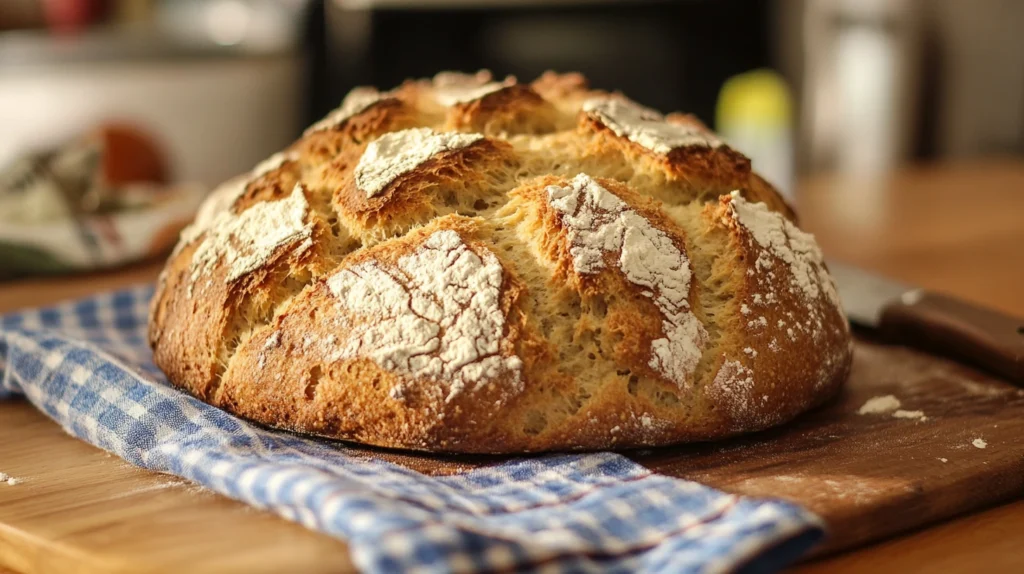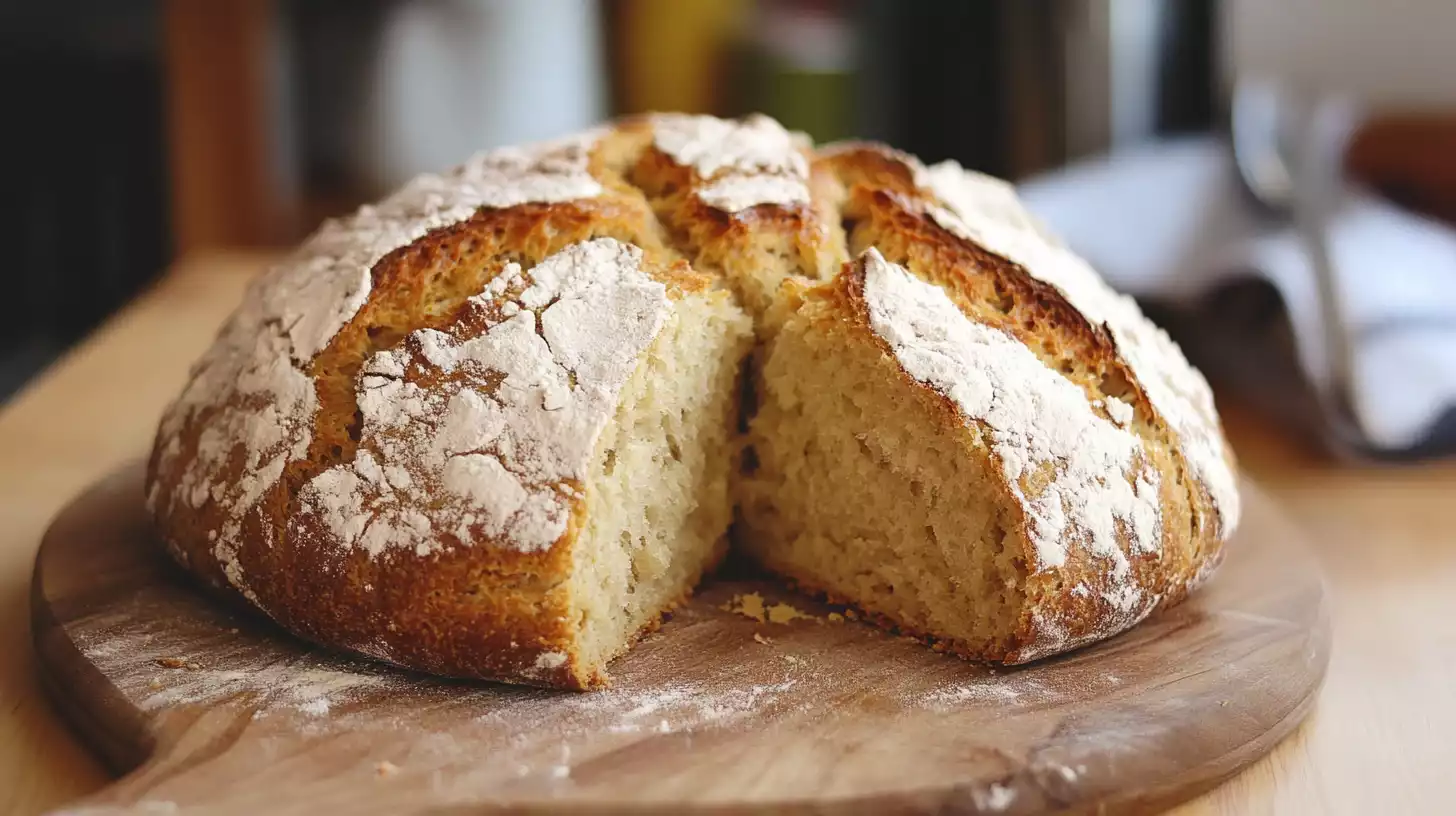What Is Special About Irish Soda Bread? Irish Soda Bread has a unique charm that makes it stand out among other types of bread. Its simplicity, rich history, and distinctive flavor make it a beloved choice in many households, especially around St. Patrick’s Day. Unlike other breads that require yeast and long fermentation processes, Irish Soda Bread relies on a simple combination of baking soda and buttermilk, making it not only quick to prepare but also uniquely delicious.
The History of Irish Soda Bread
Origins and Cultural Significance
Irish Soda Bread dates back to the 19th century in Ireland, where it was born out of necessity. The country’s climate didn’t support the growth of wheat suitable for traditional bread, so people turned to the more abundant oat and barley flours. The use of baking soda as a leavening agent was a game changer, allowing bread to rise without yeast, which was difficult to come by at the time.
Baking soda, or sodium bicarbonate, was a common ingredient introduced in Ireland during the 19th century, replacing yeast in bread recipes. It revolutionized bread-making for many Irish households, providing a quick and easy way to bake fresh bread without long preparation times.
How It Became a Staple in Ireland
Irish Soda Bread became a staple for many reasons: it was easy to make with just four ingredients (flour, baking soda, salt, and buttermilk), and it was affordable, even during tough times. It became a crucial part of daily life, especially for rural families with limited resources. Over the years, the bread evolved and became a symbol of Irish tradition, often associated with hospitality and celebrations.
What Makes Irish Soda Bread Different from Other Breads?
The Role of Baking Soda as a Leavening Agent
One of the key differences between Irish Soda Bread and other types of bread is the leavening agent. Unlike traditional bread that uses yeast, Irish Soda Bread uses baking soda, which reacts with the acidic buttermilk to help the bread rise. This gives Irish Soda Bread its characteristic dense yet soft texture, making it different from the fluffy texture of breads like baguettes or sourdough.
No Need for Yeast or Long Fermentation
Another standout feature of Irish Soda Bread is its simplicity. Traditional breads require time to rise and ferment, while Irish Soda Bread can be made in a fraction of the time. The quick process makes it an ideal bread for busy households or situations where you don’t have time to wait for dough to rise. This “no-yeast” approach makes the bread accessible and easy to prepare, even for beginners.
Simple, Readily Available Ingredients
Irish Soda Bread relies on just a few simple ingredients, most of which are pantry staples. It typically includes flour, baking soda, salt, and buttermilk. These ingredients are easy to find in most homes and grocery stores, making this bread an accessible and cost-effective option for anyone looking to bake at home.

Traditional Ingredients of Irish Soda Bread
The Classic Four Ingredients
The classic recipe for Irish Soda Bread contains only four ingredients: flour, baking soda, salt, and buttermilk. Buttermilk, which is a byproduct of churning butter, was a common ingredient in Irish households, adding moisture and a slight tang to the bread.
Flour used in traditional Irish Soda Bread is typically a soft wheat flour, and sometimes a bit of whole wheat flour is added for extra flavor and texture. The simplicity of the ingredients is part of what makes this bread so special.
Variations with Buttermilk, Whole Wheat, and Add-Ins
Although the basic recipe remains simple, variations of Irish Soda Bread are common. Some bakers swap out the white flour for whole wheat, resulting in a denser, heartier bread with a nutty flavor. Other versions may include add-ins like raisins, caraway seeds, or even cheese for extra flavor. These variations allow for creativity while still maintaining the essence of the traditional recipe.
The Unique Texture and Flavor of Irish Soda Bread
Crisp Crust and Soft, Dense Interior
Irish Soda Bread is known for its contrasting textures. The exterior features a crisp, golden-brown crust that gives way to a soft, dense, and slightly crumbly interior. This hearty texture makes it perfect for pairing with rich soups, stews, or enjoying simply with a spread of butter. The balance of crunchy and soft provides a satisfying bite in every slice.
Slightly Tangy and Mildly Sweet Taste
The flavor of Irish Soda Bread is unique and well-rounded. The buttermilk imparts a subtle tang, while the baking soda contributes a gentle sweetness. These elements create a bread that’s neither overly heavy nor intensely flavored, but rather mild and comforting. This light tang and sweetness make Irish Soda Bread a versatile companion to both savory and sweet toppings.
Symbolism and Traditions of Soda Bread
The Signature Cross on Top: Meaning and Purpose
One of the most iconic features of Irish Soda Bread is the cross on top. The cross, traditionally cut into the dough before baking, has symbolic significance. It is believed to ward off evil spirits, and some even say it’s meant to allow the bread to rise evenly. Today, the cross is a beloved part of the bread’s tradition, representing good fortune and protection.
Irish Soda Bread in Celebrations and Holidays
Irish Soda Bread holds a special place in Irish culture and is often featured at celebrations, especially around St. Patrick’s Day. It is also commonly made for other special occasions such as birthdays, Easter, and weddings. The bread’s connection to family, community, and tradition is a key part of its enduring popularity.
Modern Variations of Soda Bread
Sweet Versions with Raisins, Honey, or Sugar
While traditional Irish Soda Bread is typically a savory treat, many modern variations include sweetened versions. These might feature raisins, currants, or dried fruits, and may even be flavored with honey or sugar. These additions offer a delightful contrast to the more traditional, savory style.
Savory Options with Herbs, Cheese, or Seeds
On the savory side, Irish Soda Bread can be modified by adding ingredients like herbs (such as rosemary or thyme), cheese, or seeds. These variations add extra layers of flavor, making the bread even more versatile for a wide range of meals.

How to Enjoy Soda Bread
Best Ways to Serve It
Irish Soda Bread is delicious on its own, but it’s even better when paired with other foods. It’s often served alongside stews, soups, or hearty dishes. You can also enjoy it with butter, jam, or cheese, or use it to make a sandwich.
Traditional Irish Pairings
In Ireland, Irish Soda Bread is often served with butter and jam for breakfast or tea. It also pairs beautifully with traditional Irish dishes like beef stew, lamb, or Irish breakfast. The possibilities are endless when it comes to enjoying this bread.
FAQs About Irish Soda Bread
Why Does Irish Soda Bread Have a Cross on Top?
The cross on top of Irish Soda Bread serves both a practical and symbolic purpose. Traditionally, it’s believed to help ward off evil spirits, ensuring protection for the home. It also helps the bread bake evenly by allowing the dough to expand properly while cooking. The cross makes it easier to slice the dough before baking, ensuring that the bread cooks uniformly. It’s an iconic symbol that has been passed down through generations. Additionally, some people believe it blesses the bread and the home.
Is Irish Soda Bread Healthier Than Regular Bread?
Irish Soda Bread can be a healthier option compared to some other types of bread, depending on the ingredients used. When made with whole wheat flour, it provides more fiber and essential nutrients than white bread. It is often lower in fat and sugar, which makes it a great choice for those looking for a less indulgent option. However, it still contains carbs and calories, so moderation is important. The bread’s simplicity means it’s free from preservatives, which can also be a health benefit. But as with any bread, portion control is key.
Can You Make Gluten-Free Soda Bread?
Yes, gluten-free versions of Irish Soda Bread are possible with a few simple substitutions. By replacing the regular wheat flour with gluten-free flour, you can cater to those with gluten sensitivities. Ensure that the buttermilk and baking soda are also gluten-free, as some brands may contain traces of gluten. You might need to experiment with different gluten-free flour blends to achieve the right texture and taste. The result will still be a delicious and slightly tangy bread, similar to the traditional version. Just be sure to follow gluten-free baking instructions for the best results.
Conclusion about What Is Special About Irish Soda Bread?
Irish Soda Bread’s unique combination of simplicity, flavor, and history has made it a beloved staple in kitchens around the world. Whether you’re baking it for a special occasion or enjoying it as part of your everyday meals, this bread is as versatile as it is delicious. With modern variations, there’s a version of Irish Soda Bread for everyone to enjoy. Its timeless appeal will continue to captivate people for generations to come.

